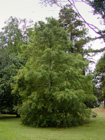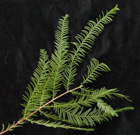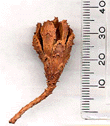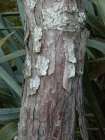
The "King of the Water Pine" in Fujian; different sources say 25 or 26 m tall, 697 or 850 cm girth, 1100 or 2100 years old [Jean Hoch, Facebook post 2021.08.13].

An ornamental tree at Yatton Park, Tauranga, New Zealand [C.J. Earle, 2003.03.03].

Foliage from the above tree [C.J. Earle, 2003.03.03].

Seed cone [Michael Frankis, ca. 2002].

Bark of an ornamental specimen in Auckland, New Zealand [C.J. Earle, 2003.03.12].

Illustration at the Flora of China website (Wu and Raven 1999).

Conservation Status

Glyptostrobus pensilis
(Staunton ex D.Don) K.Koch 1873
Common names
Water pine, shui song [Chinese] (Cheng and Fu 1978), Chinese deciduous cypress, Canton water pine (Dallimore et al. 1967), Chinese swamp cypress (Coffman 2015), Thông nuóc, Thuy tùng, H'ral [Vietnamese] (FIPI 1996).
Taxonomic notes
The sole species in Glyptostrobus Endlicher 1847.
Synonymy:
- G. lineatus (Poiret) Druce;
- G. heterophyllus Endlicher;
- G. sinensis Loder;
- Taxodium heterophyllum Brongniart;
- Taxodium sinense Forbes;
- Thuja lineata Poiret;
- Thuja pensilis Staunton.
Description
Tree 20-30 m tall and 60-70(-120) cm dbh. Crown conical, lower branches spreading, upper ones more erect. Air roots grow from lateral roots, and spread up to 6-7 m around the base of tree. Bark thick, greyish-brown, longitudinally fissured. Shoots of two kinds, long and short. Leaves delicate green when young, rich brown in autumn; those on the long shoots (representing fruiting branchlets and mature persistent vegetative branchlets) overlapping and scale-like; those on the short shoots (representing terminal barren branchlets) needle-like, sickle-shaped, enlarged at the base, quadrangular in cross section, 8-12 mm long, on one-year shoots and young trees 2-ranked. Pollen cones terminal on short shoots. Ovulate cones terminal on lateral shoots, pear-shaped or ovate, 12-18 mm long, stalked, disintegrating. Cone scales obovate, thin, bearing wart-like, sub-apical teeth and a small, triangular mucro above their centre. Seeds ovate or oblong, 5-6 mm long, thin-coated and terminated by a hatchet-shaped wing about 3 mm long. Cotyledons 4-5 (Dallimore et al. 1967, Vidakovic 1991, FIPI 1996). See García Esteban et al. (2004) for a detailed characterization of the wood anatomy.
Similar to Taxodium, from which it differs in having pear-shaped, long-stalked cones, obovate scales, and small-winged seeds (Dallimore et al. 1967). It resembles Taxodium in most other ways, such as having pneumatophores or "knees", root-derived structures that project into the air and are common on trees that grow in saturated soils (Coffman 2015).
Distribution and Ecology
China: Guangzhou, usually in low, damp, riparian areas (Dallimore et al. 1967, Vidakovic 1991); Laos: Borikhamxai; Viet Nam (Averyanov et al. 2014). Formerly, it was common in many provinces of Viet Nam, now only found in some places of Dac Lac province (Ea H' Leo and Krong Buk districts). Grows as a dominant tree in permanently inundated swampy forest, sometimes in pure stands (FIPI 1996). Hardy to Zone 8 (cold hardiness limit between -12.1°C and -6.7°C) (Bannister and Neuner 2001).
Fewer than 100 individuals still exist in Viet Nam and they must be effectively protected in Krong Buk Nature Reserve and developed by vegetative production FIPI 1996.
Remarkable Specimens
Coffman (2015) reports trees up to 45 m tall, but presents no evidence. The largest measurements I have seen reported are for the tree shown here, supposedly the largest in China; as shown, the measurements are ambiguous, but at a minimum indicate 25 m tall and 222 cm dbh, far larger than any other measurements. A tree 25.2 m tall and 102 cm dbh grows at the Christchurch Botanic Gardens in New Zealand (New Zealand Notable Trees CR/1071, 2012.12.26). The largest reported tree in the U.S. is 19.8 m tall and 44.7 cm dbh (65 ft by 55.25 in girth), for a tree in the Arboretum at the University of California, Davis (Arthur L. Jacobson email 2007.08.24).
Ethnobotany
The timber is highly valued, aromatic with fine texture, resistant to termites and insects, easy to work. Used for cabinet work, fine art articles, musical instruments, office furniture, and turnery. The root is soft and spongy and can be used for making corks and life buoys FIPI 1996.
Observations
The species is not uncommon in warm-temperate or subtropical botanical gardens and arboreta, but I have no information on finding it in habitat.
Remarks
The genus name means "cut into the cone", referring to the margins of the seed scales. The origin of the epithet is unclear, but is possibly from the Latin pencillatus, pencil-shaped, in reference to the twigs.
Has "breathing roots" as in Taxodium (Vidakovic 1991).
Citations
Averyanov, L. V., T. H. Nguyen, K. N. Sinh, T. V. Pham, V. Lamxay, S. Bounphanmy, S. Lorphengsy, L. K. Phan, S. Lanorsavanh, and K. Chantthavongsa. 2014. Gymnosperms of Laos. Nordic Journal of Botany 32(6):765–805.
Coffman, Gretchen C. 2015.02.04. What’s the Worth of a Single Tree Species? https://blog.nationalgeographic.org/2015/02/04/whats-the-worth-of-a-single-tree-species/#, accessed 2018.08.06.
See also
The species account at Threatened Conifers of the World.
BotanyVN. 2010. Preliminary observation of native Glyptostrobus pensilis (Taxodiaceae) stands in Vietnam. www.botanyvn.com/cnt.asp?param=news&newsid=1164&lg=en, accessed 2015.10.17.
Fagen L. I. and Nianhe X. I. A. 2005. Population structure and genetic diversity of an endangered species, Glyptostrobus pensilis (Cupressaceae). Botanical Bulletin of Academia Sinica 46:155-162. Available ejournal.sinica.edu.tw/bbas/content/2005/2/Bot462-09.html, accessed 2015.10.17.
Farjon (2005).
Hiep et al. 2004.
LePage, Ben A. 2007. The Taxonomy and biogeographic history
of Glyptostrobus Endlicher (Cupressaceae). Bulletin of the Peabody Museum of Natural History 48(2):359-426.
Luu and Thomas (2004) provide a recent description, range map, conservation status, drawings and photos, and a wealth of additional information.
Wu and Raven (1999).






